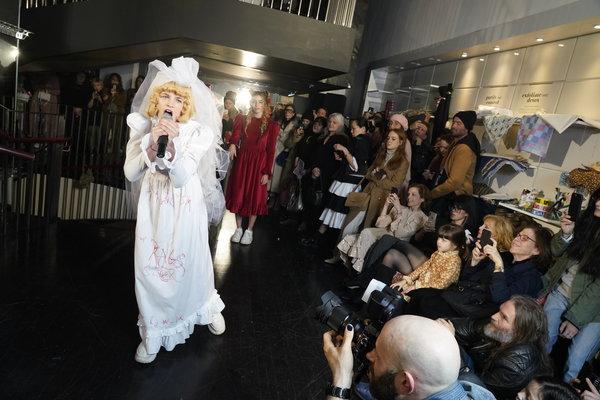A model in a print Batsheva dress appeared at a microphone on a balcony on West Broadway and solemnly declaimed. “I am doll parts,” she said. “Bad skin. Doll heart.”
If you knew these words, you really knew them. This was the rallying cry of an angry slice of a generation: one that had blossomed into fury with Hole, who screamed along with its lead singer, Courtney Love, on records like “Live Through This” and at frenetic live shows.
Model after model stepped to the mic and chanted snatches of Hole songs, alternately angry, bruised, fearsome and mocking. Beneath their wigs and braids, a few were recognizable: Christina Ricci, Veronica Webb, Annabelle Dexter-Jones, Theodora Richards. Below, on a couch that was the space’s only seating, sat Ms. Love herself, gazing upward, Instagramming.
Batsheva Hay found fame designing what were popularly referred to as prairie dresses, modest little frocks in Laura Ashley fabrics. She has often played up the sweetness inherent in the premise, as she did last season, when she staged a fashion presentation as old diner, with model-waitresses bearing French fries.
Now her models were picking up the darker undercurrent and spitting Love-isms — “Hooker-waitress, model-actress / Oh, just go nameless” — as a small battalion of sewing machines whirred below.
Ms. Hay has cited Ms. Love and her “Kinderwhore aesthetic” as an inspiration before, part of a lineage that includes Cindy Sherman and other chroniclers of the restless feminine divine. Her look, she wrote in a note after the presentation, “was so of that time but she was also so ahead of her time.”
Ms. Hay’s circle includes friends of Ms. Love’s, like the psychoanalyst Jamieson Webster and the former Hole bassist Melissa Auf der Maur, who produced the music for the show and came up with the idea of having the models read the lyrics.
Eventually, Ms. Hay and Ms. Love ended up direct messaging on Instagram.
Despite her much publicized baby-doll dresses, Ms. Love had her Laura Ashley moments, too.
“That Laura Ashley green corduroy jumpsuit with yellow flowers?” she said. “I had that in the ’90s. I wore it till the wheels fell off. I wore it traveling so people wouldn’t know it was me. The persona was always ahead. Wearing a ripped dress, whatever. I actually flew with Sheryl Crow to Canada where she was doing Lilith, and I was doing a dark edge fest. I was dressed like a housewife, and she was wearing all leather and Fly Shades.”
Ms. Love had an inkling there would be some tribute to her at the show, but she hadn’t anticipated the reading or the final performance of “Miss World” by Esther Rose McGregor, one of Ewan McGregor’s daughters. She was wearing a veil and a wedding dress on which Ms. Hay had invited Ms. Love to scribble whatever she wanted in red Sharpie.
The dress came back with words from Hole’s “Good Sister/ Bad Sister”: “Better watch your back, sister.” In her earlier scribbling days, Ms. Love was sometimes seen with words like “slut” and “witch” written in lipstick on her forearms.

Esther Rose McGregor performing the Hole song “Miss World” as Ms. Love snapped photos. CreditRebecca Smeyne for The New York Times
“It really moved me,” she said of the performance, though she said she hadn’t known what to do with her hands during it. Being confronted with a specter of one’s younger self is a surrealism most of us won’t know.
But the lyrics, Ms. Love said, held up. “Some of them I really, really love,” she said. “Some of them are too out there and commercial, and everyone knows them. The important thing for me, then and now, is it has to look good on the page. I mean, you can love Led Zeppelin and not love their lyrics sort of thing, but I made a big effort in my career to have what’s on the page mean something.”
Their sense of righteous female rage hasn’t dated much, a reporter said, in rock or outside of it.
“It certainly hasn’t,” Ms. Love said. On a trip to Scotland with her daughter, Frances Bean Cobain, she bought what she called “little niche rock magazines that are still out”: Mojo, Q, Classic Rock.
“Frances was like, You’re like the granny with her hobby,” she said. “Throwing them, yelling. The only women who were in ’em were Joan and Debbie and maybe some Patti. I was like, what, what? Slash on every page! They’re all cool. But where are the chicks? It’s like it didn’t happen.”
“But for Batsheva,” she added, “I thought it was juxtaposed really well.”







